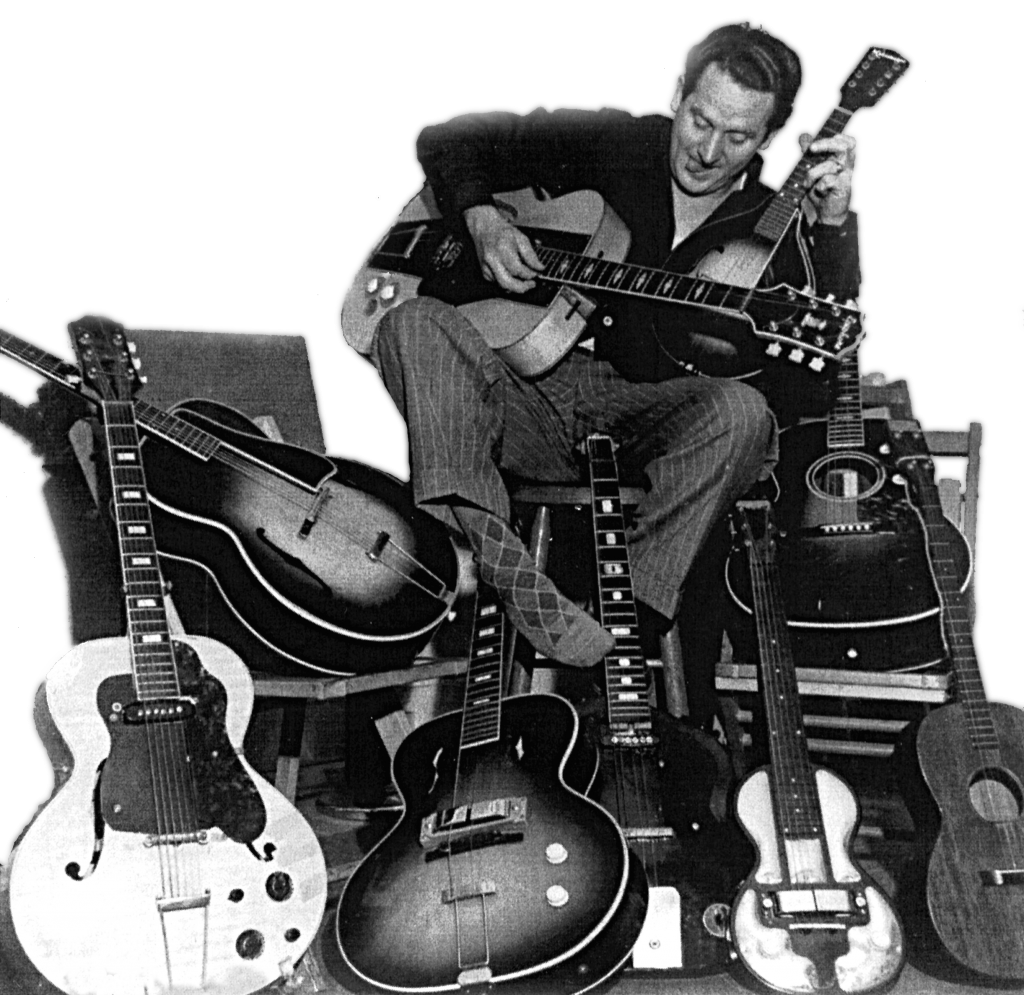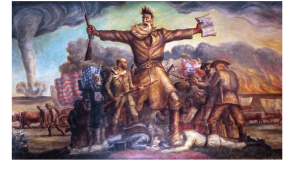From a very early age, it was obvious that young Lester William Polsfuss had a knack for music. But by his mid teens, it became clear that it was more than just a knack; he was virtually a prodigy. Starting around eight years old, young Lester toyed with anything he could get a melodic sound out of, but, after picking up a guitar, his obsession and passion for sound quickly blossomed into a fruitful career that would go down in music history.
Before he was even a teenager, he was making money in tips performing around his hometown of Waukesha, Wisconsin. By 1934, Lester, then in his early teens, had dropped out of high school and was performing in and around Chicago. He had encountered many obstacles of the music electronics of the day.[1. Salem Press Biographical EncyclopediaResearch Starters, 2017, s.v. “Les Paul,” by John R. Holmes.] Guitars were simple and all somewhat similar, and recording music with a full band was a troublesome and repetitive ordeal. He did not intend to be limited by either of these issues. Rather than fall into the repetition of the music industry of his day, he began to set himself apart by experimentation.
Lester’s instrument ideas were at first shot down by large corporations. In 1941, he even brought one of his first solid-body guitar prototypes to Gibson, but the company quickly dismissed him.1 This rejection seemed to motivate him even more, and he returned to the drawing board while his performing career began to culminate.
He despised the fact that his early music sounded so similar to other artists of the day. Because of this, in 1947, Polsfuss started his own recording studio, in which he began utilizing over-dubbing and multitrack recording, which allows one musician to record one instrument at a time and overlay them so that it seems that they are being played at the same time.2 Although it was at first a venture for his own personal music, many musicians flocked to his home studio wanting to be recorded by Lester.
Just as these endeavors were taking off, in 1948, Lester suffered an almost career ending injury, in which his elbow was crushed beyond the point of reconstruction. He made the choice to have his right arm permanently set at less than a 90 degree angle, leaving him the ability to cradle a guitar.3 This action alone is a prime example of the dedication that Polsfuss possessed. Instead of letting his accident end his playing, or let his early failures deter him, he continued to strive to improve and increase the options for creativity that musicians had. He tried again to invent a solid body guitar and new sound recording techniques, all while continuing to work on his own music.
His talent on the guitar gained him so much attention that Gibson, while still unwilling to accept his prototype guitar model, decided to hire him as somewhat of a consultant.4 They wanted his name associated with their product, and they wanted his unmatched innovative mindset. The company created their own solid-body guitar model with the help of Lester, and the name came naturally.5 The Les Paul guitar was created, while Lester came to reach the pinnacle of his fame.

Unwillingness to settle was what set Lester apart from other musicians of the day—his constant need to experiment and create something better or at least different. Rather than just becoming the best he could be at the instruments of the day, he almost seemed more interested in creating new and improved devices to improve his playing. Without this determination, he might have just been another musician in history.
Les Paul, suffering from injury, old age, and arthritis, still continued to play guitar and work with music until his death in August of 2009.3 His lifetime achievements consist of his induction into the Rock and Roll Hall of Fame in 1988, a National Medal of Arts in 2007, multiple Grammys and Emmys, and countless other honors. While his guitar playing styles were an influence to guitarists everywhere, his greatest influences on the music industry were his help in creating a solid body guitar and his creation of over-dubbing and multi-track recording, which have been used by almost every musician since. His name has been immortalized in music history because of his contributions, and any fan or member of the music community has reason to thank him.
- Paul Verna, “‘Just A Pure Genius’: celebrating the legacy of Les Paul, the tinkerer who (really) helped invent rock’n’roll,” Billboard, (2015): 67. ↵
- “The Man Before The Guitar: Remembering Les Paul At 100,” All Things Considered, (June 9, 2015). ↵
- Salem Press Biographical EncyclopediaResearch Starters, 2017, s.v. “Les Paul,” by John R. Holmes. ↵
- “Les Paul and the Electric Guitar,” Innovation Masters: History’s Best Examples of Business Transformation, (2012): 196-199. ↵
- Calen D. Stone, “Paul, Les,” Contemporary Musicians, Vol. 2, (1990): 186-188. ↵
- Salem Press Biographical EncyclopediaResearch Starters, 2017, s.v. “Les Paul,” by John R. Holmes. ↵



52 comments
Emily Rodriguez
As someone who has a brother that is a musician and owns many guitars, one including a Les Paul, it was very interesting to read about the making of it and who Les Paul was. I had no idea about his permanent injury and the risk he took when making a decision to set his arm permanently. It goes to show that you can do anything you put your mind to if you love it enough. Great job.
Kenneth Cruz
This was a great article to read, Joel! It was very well written and had a great story to it. I never knew the history of the Les Paul guitar was as prominent as it was. I’m a bassist so I don’t look at standard 6-string guitars much, but after reading this I can say I gained a new respect for the instrument. If I were to ever get one, I’d definitely think about this article every time I play it.
Elliot Avigael
I’m kind of embarrassed at myself as a two-time Les Paul owner I did not know the story behind it. It’s amazing how far that group of guitars has come; from being used in blues and jazz to now becoming a favorite of hard rockers and metalheads. From my experience, that’s exactly the beauty behind a Les Paul…its ability to deliver crushing riffs, but also being able to produce blazing solos or soft jazz tunes.
An incredibly informative article about a wonderful man. Rock and Roll would not be what it is today without the brilliant mind of Les Paul.
Haley Aleman
I’m slightly ashamed to say as an owner of an epiphone les paul, I didn’t know the story behind my own guitar. Ha! It’s truly incredible to know that it came from such humble beginnings. I never knew about a man named Lester with a nearly shredded arm, but I sure have a lot to thank him for, as does anyone else who has a passion for music. What a wonderful man with an even better story of drive and determination. A wonderful edition to the world he was, great article.
Eliezer Leal
What an inspiring article. Les Paul is definitely a prime example of a person following their dreams no matter what. Les went through so much to achieve his goal. Between rejection and a nearly career ending injury he never gave up he worked harder to do what he wanted. You should never give up on your dreams if you struggle, just work harder to achieve them.
Audrey Uribe
Being a musician this story was very enjoyable! I own a Les Paul guitar myself and have quite a passion for guitar but reading and hearing about Les Paul’s journey aside from his pure talent is heart filling. I was unaware that his whole elbow was crushed beyond repair. This just shows that no matter what it is, you can always find a way to continue your passion.
Judson Ruddick
As an avid gear head I found the title to be somewhat misleading. The title seems to imply that Les invented the first guitar, which of course isn’t true. He didn’t even invent the first electric solid body guitar, but the innovation he brought to the industry was unprecedented. The inclusion of his injury in the article was surprising and pleasing since it’s an important event in his life that not many people seem to know or recognize. I do wish that the article was more focused on Lester’s involvement in creating the first Les Paul prototype and the subsequent changes made rather than giving a quick synopsis of his life. The Les Paul is one of if not the most iconic guitar model to ever exist and it was a product of Les Paul’s obvious dedication and passion for music.
Jose Chaman
This article is great, I’ve always heard about the mythical name Les Paul (Slash guitars), but I never ventured to investigate his history. Les Paul is an example of perseverance and innovation. His history shows us that by loving what we do we can go far, this story is very motivating. Hopefully this year I can buy a Gibson Les Paul to follow the legacy!
Michael Lazcano
The Gibson Les Paul guitar is iconic, not only in the music industry, but it has also entered into the mainstream culture. Everyone in their lifetime has heard the name Les Paul once, and Lester Polsfuss’ work as a musician and his work ethic is to be attributed to his success. The history that the author presented gave me a clearer picture to who Lester was, how he reached legendary status, and his tremendous drive for his passion. Lester is a prime example of giving yourself up to being the best in whatever field of expertise. Not only should all musicians take a page out of his book, but anyone passionate about anything should know the story of Lester Polsfuss.
Vanessa Sanchez
I’ve never really knew anything about Guitars at all until i read this article. Les Paul is obviously the expensive brand out there and it’s made perfect, to the point where people tried to copy his work. I like how this article brought out the obsicules that Lester had to go through to get his guitar idea to come to life with the big industries. Many have turned him down but that didnt stop it, it motivated him to do better. He suffered an accident where it could have ended his career, With that, it just strived him to create guitars to the point where they finially acceoted his ideas. This was a good article to read about Les Paul to know more about the background on how it got created and the struggles Lester went through to achieve his dreams.